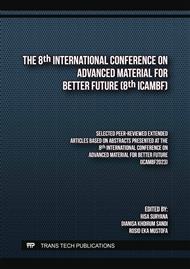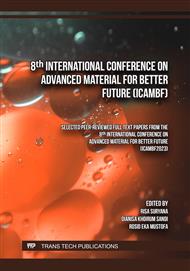[1]
E.Y. Lee and K.H. Yoon, "Epidemic obesity in children and adolescents: risk factors and prevention," Front. Med., vol. 12, no. 6, p.658–666, 2018.
DOI: 10.1007/s11684-018-0640-1
Google Scholar
[2]
S. Ghosh, M. Paul, K.K. Mondal, S. Bhattacharjee, and P. Bhattacharjee, "Sedentary lifestyle with increased risk of obesity in urban adult academic professionals: an epidemiological study in West Bengal, India," Sci. Rep., vol. 13, no. 4895, p.1–10, 2023.
DOI: 10.1038/s41598-023-31977-y
Google Scholar
[3]
T. Lobstein, R. Jackson-leach, J. Powis, H. Brinsden, and M. Gray, "World Obesity Atlas 2023," 2023. https://data.worldobesity.org/publications/?cat=19 (accessed Apr. 02, 2023).
Google Scholar
[4]
T. Buchholz and M. F. Melzig, "Polyphenolic Compounds as Pancreatic Lipase Inhibitors," Planta Med., vol. 81, p.771–783, 2015.
DOI: 10.1055/s-0035-1546173
Google Scholar
[5]
B.G. Tchang, K.H. Saunders, and L.I. Igel, "Best Practices in the Management of Overweight and Obesity," Med. Clin. North Am., vol. 105, no. 1, p.149–174, 2021.
DOI: 10.1016/j.mcna.2020.08.018
Google Scholar
[6]
M.M. Li, Y.T. Chen, J.C. Ruan, W.J. Wang, J.G. Chen, and Q.F. Zhang, "Structure-activity relationship of dietary flavonoids on pancreatic lipase," Curr. Res. Food Sci., vol. 6, no. 100424, p.1–8, 2023.
DOI: 10.1016/j.crfs.2022.100424
Google Scholar
[7]
A.N. Panche, A.D. Diwan, and S.R. Chandra, "Flavonoids: An overview," J. Nutr. Sci., vol. 5, no. e47, p.1–15, 2016.
DOI: 10.1017/jns.2016.41
Google Scholar
[8]
S.A. Pai, E.A. Martis, R.P. Munshi, M.S. Gursahani, S.N. Mestry, and A. R. Juvekar, "Chrysin mitigated obesity by regulating energy intake and expenditure in rats," J. Tradit. Complement. Med., vol. 10, p.577–585, 2020.
DOI: 10.1016/j.jtcme.2019.09.002
Google Scholar
[9]
Y.J. Zhou, N. Xu, X.C. Zhang, Y.Y. Zhu, S.W. Liu, and Y.N. Chang, "Chrysin Improves Glucose and Lipid Metabolism Disorders by Regulating the AMPK/PI3K/AKT Signaling Pathway in Insulin-Resistant HepG2 Cells and HFD/STZ-Induced C57BL/6J Mice," J. Agric. Food Chem., vol. 69, p.5618–5627, 2021.
DOI: 10.1021/acs.jafc.1c01109
Google Scholar
[10]
C. Rodríguez-Pérez, A. Segura-Carretero, and M. del Mar Contreras, "Phenolic compounds as natural and multifunctional anti-obesity agents: A review," Crit. Rev. Food Sci. Nutr., vol. 59, no. 8, p.1212–1229, 2017.
DOI: 10.1080/10408398.2017.1399859
Google Scholar
[11]
R. Kumar, S. Vijayalakshmi, and S. Nadanasabapathi, "Health Benefits of Quercetin," Def. Life Sci. J., vol. 2, no. 2, p.142, 2017.
DOI: 10.14429/dlsj.2.11359
Google Scholar
[12]
M. H. Hamdaoui et al., "Tea decoctions prevent body weight gain in rats fed high-fat diet; black tea being more efficient than green tea," J. Nutr. Intermed. Metab., vol. 6, p.33–40, 2016.
DOI: 10.1016/j.jnim.2016.07.002
Google Scholar
[13]
P. Mangal, P. Khare, S. Jagtap, M. Bishnoi, K. K. Kondepudi, and K. K. Bhutani, "Screening of six Ayurvedic medicinal plants for anti-obesity potential: An investigation on bioactive constituents from Oroxylum indicum (L.) Kurz bark," J. Ethnopharmacol., vol. 197, p.138–146, 2017.
DOI: 10.1016/j.jep.2016.07.070
Google Scholar
[14]
T. Hengpratom, G. M. Lowe, K. Thumanu, S. Suknasang, K. Tiamyom, and G. Eumkeb, "Oroxylum indicum (L.) Kurz extract inhibits adipogenesis and lipase activity in vitro," BMC Complement. Altern. Med., vol. 18, no. 177, p.1–14, 2018.
DOI: 10.1186/s12906-018-2244-3
Google Scholar
[15]
S.A. Acevedo, A.J.D. Carrillo, E.F. Lopez, and C.D. Grande-Tovar, "Recovery of Banana Waste-Loss from Production and Processing: A Contribution to a Circular Economy," Molecules, vol. 26, no. 17, p.1–32, 2021.
DOI: 10.3390/molecules26175282
Google Scholar
[16]
N.R. Putra, A. H. A. Aziz, A. N. M. Faizal, and M. A. Che Yunus, "Methods and Potential in Valorization of Banana Peels Waste by Various Extraction Processes: In Review," Sustainability, vol. 14, no. 17, p.10571, 2022.
DOI: 10.3390/su141710571
Google Scholar
[17]
A.M. Aboul-Enein, Z.A. Salama, A.A. Gaafar, H.F. Aly, F.A. Bou-Elella, and H.A. Ahmed, "Identification of phenolic compounds from banana peel (Musa paradaisica L.) as antioxidant and antimicrobial agents," J. Chem. Pharm. Res., vol. 8, no. 4, p.46–55, 2016, [Online]. Available: www.jocpr.com.
Google Scholar
[18]
N. Sanghavi, S. D. Bhosale, and Y. Malode, "RP-HPLC method development and validation of Quercetin isolated from the plant Tridax procumbens L.," J. Sci. Innov. Res., vol. 3, no. 6, p.594–597, 2014.
DOI: 10.31254/jsir.2014.3609
Google Scholar
[19]
K. Vajramma, S. Begum, S. A. Begum, Jayasree, and K. Bharathi, "RP-HPLC Method Development and Validation for Determination of Labetalol in Bulk and Marketed Formulation.," Int. J. Pharm. Biol. Sci., vol. 9, no. 1, p.602–611, 2019.
DOI: 10.33786/jcpr.2018.v08i03.007
Google Scholar
[20]
E. Sulastri et al., "Total phenolic, total flavonoid, quercetin content and antioxidant activity of standardized extract of moringa oleifera leaf from regions with different elevation," Pharmacogn. J., vol. 10, no. 6, pp. S104–S108, 2018.
DOI: 10.5530/pj.2018.6s.20
Google Scholar
[21]
PubChem, "PubChem Compound Summary for CID 5280343, Quercetin," 2023. https://pubchem.ncbi.nlm.nih.gov/compound/Quercetin (accessed Jul. 03, 2023).
DOI: 10.7717/peerj.14915/fig-2
Google Scholar
[22]
J.-F. Zhou et al., "Quercetin is a promising pancreatic lipase inhibitor in reducing fat absorption in vivo," Food Biosci., vol. 43, no. 101248, p.1–8, 2021.
DOI: 10.1016/j.fbio.2021.101248
Google Scholar
[23]
A. I. Martinez-Gonzalez et al., "In vitro inhibition of pancreatic lipase by polyphenols: A kinetic, Fluorescence spectroscopy and molecular docking study," Food Technol. Biotechnol., vol. 55, no. 4, p.519–530, 2017.
DOI: 10.17113/ftb.55.04.17.5138
Google Scholar
[24]
X. Dong, Y. Cao, N. Wang, P. Wang, and M. Li, "Systematic study on solubility of chrysin in different organic solvents: The synergistic effect of multiple intermolecular interactions on the dissolution process," J. Mol. Liq., vol. 325, no. 115180, p.1–15, 2021.
DOI: 10.1016/j.molliq.2020.115180
Google Scholar
[25]
L. Pratiwi, A. Fudholi, R. Martien, and S. Pramono, "Ethanol Extract, Ethyl Acetate Extract, Ethyl Acetate Fraction, and n-Heksan Fraction Mangosteen Peels (Garcinia mangostana L.) As Source of Bioactive Substance Free-Radical Scavengers," JPSCR J. Pharm. Sci. Clin. Res., vol. 1, no. 2, p.71, 2016.
DOI: 10.20961/jpscr.v1i2.1936
Google Scholar
[26]
J. A. Manthey and S. Jaitrong, "An HPLC-MS Analysis of Phenolic Antioxidants in Banana Peel," Proc Fla State Hort Soc, vol. 129, no. 1, p.181–184, 2016.
Google Scholar
[27]
X. Zhao, X. Su, C. Liu, and Y. Jia, "Simultaneous determination of chrysin and tectochrysin from Alpinia oxyphylla fruits by UPLC-MS/MS and its application to a comparative pharmacokinetic study in normal and dementia rats," Molecules, vol. 23, no. 1702, p.1–11, 2018.
DOI: 10.3390/molecules23071702
Google Scholar



